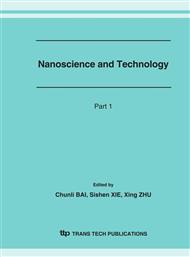p.395
p.401
p.407
p.413
p.417
p.425
p.429
p.433
p.437
Adsorptive Surface Coverage of Carbon Tetrachloride onto Carbon Nanofibers Array
Abstract:
This work explores an estimation of adsorptive surface coverage for carbon tetrachloride onto different carbon nanofibers (CNFs). Two kinds of CNFs with various pore characteristics are fabricated by template-based and thermal chemical vapor deposition methods, respectively. The pore size distributions of these carbons, determined according to the density functional theory model, are found to vary with synthesis methods. The results of adsorption experiments show that CCl4 adsorption isotherms of these CNFs are of Langmuir-type model during the restricted pressure of 0–0.2 atm at 30°C. The surface coverage capable of adsorbing CCl4 molecules onto the CNFs can be determined based on the monolayer adsorption model. Interestingly, the CCl4 capacity of these CNFs does not proportionally increase with their specific surface area, and the CNFs with more micropore fraction facilitate the adsorptive surface coverage. This finding attributes to a fact that micropores in the CNFs have stronger adsorption energies, thus, become a major provider for carbon tetrachloride adsorption.
Info:
Periodical:
Pages:
417-424
Citation:
Online since:
March 2007
Price:
Сopyright:
© 2007 Trans Tech Publications Ltd. All Rights Reserved
Share:
Citation:


